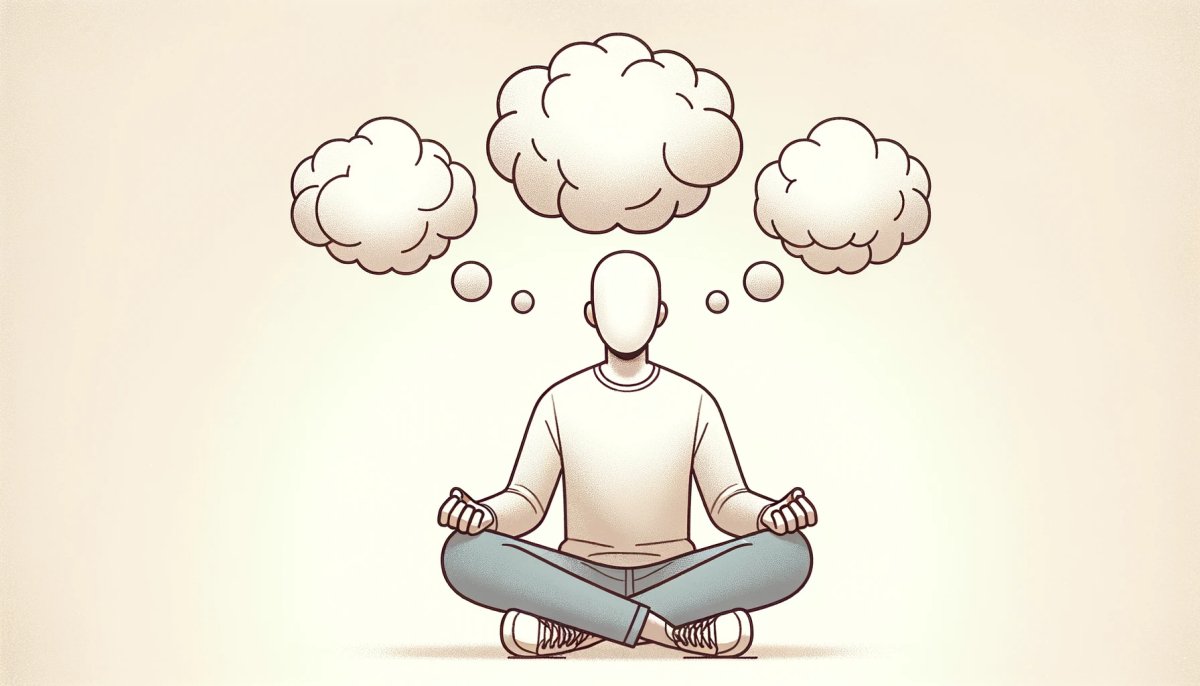
Observe Your Thoughts to Calm A Busy Mind with Mindfulness
“In the silence of observation, we unveil the symphony of our soul.” – Bayu Prihandito
Table of Contents
Key Takeaways
- Observing thoughts can be seamlessly woven into daily life, transforming mundane tasks into meditative moments.
- Thought observation provides clarity, peace, and a fresh perspective, turning each moment into an opportunity for mindfulness.
- Through consistent practice, one can find sanctuary within, amidst the external noise of life, meeting challenges with a beginner's mind.
In today's rapid-paced society, the incessant chatter of our minds often goes unnoticed. Yet, tucked away amidst this constant noise lies the transformative power of observation. Our thoughts are much like the waves of an ocean – ever-continuous, sometimes tumultuous, and at other times serene. And just as an oceanographer studies waves to understand the ocean's depths, by learning to Observe Our Thoughts, we tap into the depths of our consciousness.
Our thoughts are our life's scriptwriters. They narrate our realities, sketch our emotions, and design our actions. However, when left unchecked and unobserved, they can drive our life's narrative into paths of unrest, confusion, and emotional turbulence. On the flip side, a keen observation can transform these pathways, leading to inner peace, clarity, and purposeful living.
Why is it Important?
Observing our thoughts is not a mere mindfulness fad. Its importance stems from its profound ability to influence our entire being. Each thought that crosses our mind impacts our emotional well-being, decision-making processes, and our interactions with the world around us.
Scientific studies, such as those by Dr. Richard Davidson, have showcased that regular mindfulness practices, like observing thoughts, can lead to tangible neural changes. These changes optimize emotional responses, boost cognitive functions, and enhance overall mental well-being.
Besides, when we become active observers rather than passive participants of our thought processes, we begin to discern patterns. These patterns might manifest as recurring fears, unfounded anxieties, or even unexplored passions and dreams. Recognizing them is the first step toward personal growth, emotional freedom, and a life led with purpose and intention.
The Process of Observing Thoughts
Role of Mindfulness
Mindfulness is the quality of being fully present in the moment, embracing it without judgment. It's the art of grounding oneself in the now, regardless of where the mind might want to wander.
Observing, in the context of mindfulness, refers to neutrally watching one's thoughts and feelings as they arise, without trying to change or judge them. Imagine watching leaves float by on a river—each leaf representing a thought or emotion. The observer does not interfere with the flow, nor do they attach stories to the leaves. They simply watch.
This observational stance is transformative. By merely watching our thoughts and emotions, we begin to realize that we are not defined by them. We are the observer, distinct from the transient feelings and ideas that come and go. This realization fosters a deep sense of inner peace and equanimity.
Step-by-Step Guide

Embarking on the journey of observing thoughts is akin to setting sail on uncharted waters. While the destination is profound self-awareness and mastery over one's mind, the voyage entails understanding, patience, and consistent practice.
Here's a step-by-step guide to help in this transformative journey:
Create a Quiet Space: Find a peaceful corner, away from distractions. Whether it's a serene park, a quiet room, or even a meditative corner in your home, the environment plays a pivotal role in focusing inward.
Adopt a Comfortable Posture: Sit or lie down comfortably. Ensure that you are relaxed, yet alert. A balanced posture, such as the traditional cross-legged position or even sitting on a chair with feet firmly on the ground, can be beneficial.
Close Your Eyes and Focus on Your Breath: Taking deep breaths calms the nervous system. It acts as an anchor, pulling you into the present moment. The rhythmic inflow and outflow of breath serve as a focal point.
Shift Your Attention to Your Thoughts: Once centered, gently shift your attention from the breath to the stream of thoughts. Imagine watching a movie, where each thought is a scene, unfolding and transitioning.
Detach and Observe: As you notice thoughts, ensure you're not getting embroiled in them. Visualize yourself as a silent observer on the bank of a river, watching the water (thoughts) flow by.
Return to the Breath if Distracted: It's natural for the mind to wander or for emotions to arise. If you find yourself lost in thought, gently bring your focus back to your breathing before returning to observation.
Differences between Observing and Thinking
At its core, thinking is an active process of producing thoughts, while observing is the passive process of noticing them. When we think, we engage, deliberate, and even sometimes ruminate. Thoughts during this phase often come with intent, be it solving a problem, recalling a memory, or planning for the future.
On the other hand, observing is stepping back and watching these thoughts without getting involved. It’s akin to watching clouds drift by in the sky. You acknowledge their presence, but you don’t influence their movement. The crux of the distinction lies in engagement. While thinking is participatory, observing is distancing oneself, becoming an audience to the mind's theater.
How to Observe Thoughts Without Judgment
One of the quintessential elements of thought observation is non-judgment. But how can one master this?
| Step | Description |
|---|---|
| Acknowledge Every Thought | Whether it's a negative thought about oneself or a fleeting fantasy, acknowledge its presence without labeling it as 'good' or 'bad'. |
| Avoid Analysis | Dive deep into the role of an observer. Avoid analyzing, dissecting, or diving deep into the 'whys' and 'hows' of a thought. |
| See Thoughts as Clouds | Visual metaphors can be powerful. Imagine your thoughts as clouds in the sky – they come and go, and you're just watching them from the ground. |
| Remind Yourself of Your Role | Every time you catch yourself judging or analyzing, remind yourself – "I am here to observe, not judge." |
| Practice Compassion | Extend the same kindness to yourself as you would to a dear friend. By fostering a compassionate environment, the mind naturally drifts away from critical analysis. |
Remember, like any skill, observing without judgment requires consistent practice.
Emotional Charge & Thoughts

Every thought that goes through the mind carries with it an energy, often reflected as an emotional charge. This charge can vary in intensity from subtle and almost imperceptible, like a gentle breeze, to overpowering and tumultuous, akin to a raging storm. The genesis of this emotional energy is a complex interplay between our past experiences, beliefs, societal conditioning, and immediate environment.
For instance, a simple thought about an upcoming presentation might carry anxiety for some, while for others, it's imbued with excitement and anticipation. These emotional responses are not just about the thought itself but more about the individual’s relationship with that thought.
Understanding the emotional charge of thoughts is crucial because they significantly influence our actions, decisions, and overall well-being. A thought with a high negative charge, if unchecked, can spiral into anxiety, stress, or even depression. Conversely, positive charges can lead to feelings of happiness, contentment, and motivation.
Handling Annoying Thoughts
Annoying thoughts, often repetitive in nature, can be likened to an unwelcome song stuck on repeat. Handling them requires a blend of awareness and strategy:
Acknowledge, Don't Resist: Resistance often amplifies these thoughts. Instead, simply acknowledge their presence.
Distraction Works: Engage in an activity that requires your full attention. This naturally shifts your focus.
Question the Thought: Ask yourself, "Is this thought serving any purpose?" More often than not, you'll realize it's redundant.
Finding Peace Amidst the Mind’s Chaos
Amid the ceaseless chatter of the mind, finding peace might seem like a Herculean task. However, it's achievable with consistent effort:
Grounding Techniques: Techniques like focusing on your breath, or feeling the texture of an object, can anchor you to the present, creating a respite from chaotic thoughts.
Set Aside 'Thinking Time': Allocate specific intervals in the day for reflection. This organized approach often reduces random, disruptive thoughts.
Engage with Nature: Nature has an innate calming effect. A walk in the park, listening to the sounds of the waves, or even tending to plants can offer mental peace.
Impact of Observing on Our Relationships
When we practice observation, a profound shift occurs in how we perceive the world and our relationships. Instead of reactive responses based on past traumas or anticipated future events, observation cultivates a more responsive mindset.
In relationships, this means being fully present with our loved ones, listening deeply, and responding from a place of understanding rather than reflex. This nurtures trust, understanding, and deeper connections. Moreover, as we view the world through an observational lens, our judgments reduce. We begin to see situations and people as they are, not as we believe they should be.
Implementing Thought Observation in Daily Life

While the idea of observing one's thoughts might sound like a secluded monk's practice, it can be seamlessly be implemented into our daily lives. In an age where distractions are just a click away and our minds are perpetually scattered, adopting this practice can be a game-changer.
Start by setting a fixed time each day, even if it's just for a few minutes. Mornings are usually a good choice, as the mind is fresher and less burdened by the day's stress. However, any time that works for you is perfect.
Throughout the day, take 'observation breaks.' These are moments when you pause, even for a minute, to tune into your thoughts. Instead of being lost in them, watch them. Imagine them as clouds drifting across your mind's sky.
Integrate observation into routine activities. Whether it's while brushing your teeth, taking a shower, or even during your commute, become an observer. Over time, you'll find that not only do these mundane activities become meditative, but you also gain clarity and peace in the process.
Quick Tips & Tricks
- Timer Technique: Set a timer for every hour to take a minute or two to observe your thoughts.
- Sticky Notes: Place notes around your home or workspace as reminders to pause and observe.
- Nature Walks: Nature has a calming effect. Use your walks as an opportunity to practice thought observation.
Final Thoughts
As we navigate the intricate dance of life, the practice of observing thoughts can be our compass. It doesn’t ask for drastic changes, but rather, small shifts in awareness that have profound effects. In the cacophony of external noise, the true sanctuary lies within, in the spaces between our thoughts.
Observing our thoughts doesn't negate them but offers a fresh perspective. It's about meeting each moment with a beginner's mind, devoid of judgment, and full of curiosity.
Here at Life Architekture, we believe in integrating mindfulness practices into our lifestyles. Our experts guide you in the art of thought observation, ensuring it becomes a transformative tool in your daily life. With tailored programs and resources, we are committed to making thought observation accessible, impactful, and transformative.









